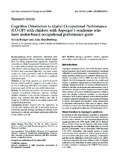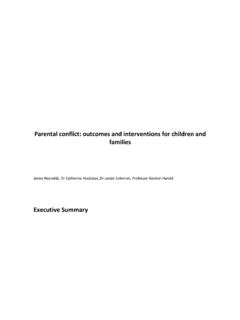Transcription of ˘ˇ ˆ - OECD.org
1 @h y 8uvyqu q @q ph v h q 8h r s 8uvyq r s G v p r Hv v 7hpxt q Dr. Paul LesemanUniversity of AmsterdamA Paper for Discussion at theOECD Oslo Workshop, June 6-7 2002 For citation , please use:Leseman, Early childhood education and care for children from low-income or minoritybackgrounds, OECD, 20022 TABLE OF 4 CHAPTER 5 INTELLIGENCE AND LEARNING IN YOUNG 5 Some recent currents in early childhood 5 behavioural and environment: reconsidering the 5 The interactionist 6 Arguments from 7 The implications of the new 7 Language, cognition, 7 Development and learning as dynamic, situated, and (co-) 9 CHAPTER 12 CHILD REARING CHALLENGES FOR LOW-INCOME AND MINORITY 12 Delineating the child population in 12 Risk accumulation and dysfunctional 13 Informal education and school 15 Traditional vs. modern child rearing 16 Bilingual and 18 CHAPTER 20 THE EFFECTS OF ORGANISED ECEC ON CHILD 20 Predominant models in 21 The evaluation of the developmental effects of early childhood 22 The efficacy of different centre-based education and care 23 The efficacy of home-based educational programmes and family 25 The developmental effects of regular child 26 Summary of programme characteristics and their 28 CHAPTER 31 PARENTAL CHOICE - SOCIO-ECONOMIC AND ETHNIC 31 Balancing price and 32 Parents consider also their child s educational future and the perceived quality of the 33 Explaining ethnic 35 The influence of macro socio-cultural 37 Some conclusions on the issue of parental 383 CHAPTER 40 Quality and efficacy.
2 Implications for the design of ECEC-systems and ECEC 40 Some new 43 Broad-based (community) schools/ parent-child 43 Head Start / Sure Start / Dutch VVE 44 Comprehensive family support systems / Integrated family welfare and child and youth care many countries, systems of early childhood care and education (ECEC) are currently underreview. A major force behind the reappraisal is the growing labour force participation of women, puttingheavy demands on the existing systems that are forced to expand their capacity and to extend theirservices. A second major force is the alleged role of ECEC in preparing children from socio-economically,disadvantaged families for formal schooling in primary school and in preventing psychosocial problems. Athird issue - arising from increased immigration to industrial countries in past decades - is the challenge toprovide for the children of cultural and linguistic minorities, although in most countries, traditional low-SES communities and indigenous minorities had never fully disappeared from national political the same time, new issues are being raised.
3 Societies are becoming aware that early childhoodis a particularly sensitive period, marked by a high degree both of adaptability and vulnerability in thedeveloping child to the stimulation and stresses of his or her environment. With this new knowledge,uncertainty has also arisen concerning the impact of changes in traditional child-rearing patterns on thecognitive and social-emotional development of the young. Does early, intensive, long-day care - as a recentstudy suggests - lead to an increase of negative, aggressive behaviour in young children ? One may disputesuch far-reaching conclusions based on a single study, conducted in a particular social and cultural disputed, however, is the fact, based on studies across many countries, that low quality in earlychildhood services may increase child- or family-related developmental risks. Further, it is well researchedthat economic and cultural mechanisms operating within ECEC systems predetermine low-income andethnic and socio-linguistic minority families to choose disproportionately the lower quality reverse side of the medal is also present, above all, the knowledge that the tremendouscapacity and adaptability of young children provide an effective starting point for preventive interventionsas part of a broader social inclusion policy.
4 Education-oriented care- and pre-school programmes are foundto contribute importantly to the development of cognitive and language skills, providing disadvantagedchildren with a head start in primary school when formal instruction recent OECD report Starting Strong (OECD, 2001) describes these developments in 12 OECD countries, detailing the recent changes in ECEC systems and national policies, revealing bothcommon challenges and diverse solutions. The present paper focuses on a specific issue within this broadframework, complementing the overview of Starting Strong: What is, or can be, the function of ECEC forchildren from low-income and minority families? What is, or can be, the role of ECEC in improving socialintegration? The approach is research based. It provides in Chapter 1 a short overview of recent currents inearly childhood research, and draws out the implications for early child development and learning from themost recent research.
5 The succeeding chapters summarise the research available in four areas important forpolicy making in support of children and families from low-income and/or minority backgrounds: Child rearing challenges for low-income and minority families The effects of organised ECEC on child development and learning Parental choice and its links with socio-economic and ethnic attributes Quality and efficacy: implications for ECEC systems design and policy5 CHAPTER 1 INTELLIGENCE AND LEARNING IN YOUNG CHILDRENSome recent currents in early childhood researchBehavioural is only three decades ago that leading psychologists argued in response to the disappointingresults of the first nation-wide evaluation of Head Start programmes in USA that the genetic-biologicalnature of cognitive competence precluded any major lasting improvements in this area by pre-schoolprogrammes (Jensen, 1969, 1991). Still, in 1994 Hernnstein and Murray (1994) referred to the supposedlybell-curve shaped distribution of genetic potential for intelligence and related skills to support their plea forabolishing affirmative action measures and other forms of compensatory and priority policy, suggestingthat genetic differences constitute the meritocratic basis for social inequalities between ethnic and racialgroups.
6 In the same year, in a provocative book, Rowe (1994) concluded that the family and culturalcommunity, seen as shared environments , have very limited impact on children s intellectual andpersonality development, in addition to genetic factors and unique, non-shared experiences. Similarstatements were made a few years earlier by Scarr (1992) in her presidential address to the Society forResearch in Child Development, who allowed for substantial environmental influence and thus forintervention effects - on child development only in cases of extreme deprivation and abuse and and environment: reconsidering the Rowe s and Scarr s arguments were based on the results of the behavioural geneticsresearch programme that expanded rapidly since the sixties and became a dominant view in psychologyand educational sciences in the eighties and early nineties.
7 The core of this programme is a researchparadigm that involves identical and non-identical twins raised apart (in different families) and together (inthe same family), and adopted children who are compared with their genetically unrelated siblings in thesame adoptive family. By computing correlations between the members of twin-pairs or between adoptedchildren and biologically non-related siblings, estimates are derived of the amount of genetically causedvariance in individual differences in, for instance, IQ, symbolised by the coefficient h2, of the amount ofvariance caused by the non-shared environment, e2 (or u2), and of the amount of the variance caused by thecommon environment, c2. Underlying this paradigm is a theoretical model, that states that the variance in agiven population in phenotype P is the sum of the variance in genotype G and the variances due to unique,E, and shared, C, environmental effects.
8 The additive model presupposes a neuro-biological developmentalmodel that assumes that the genotype directly regulates neurodevelopment and that neurodevelopment6directly regulates psychological and behavioural development. Put differently, the behaviour geneticresearch programme heavily leans on the assumption of the innateness of psychological this paradigm, the results accumulating from several studies in several countriesconverge. For instance, the h2 of IQ is found to range between .6 and .8 ( is the maximum), whereas theremaining variance is largely attributable to unique environmental causes that include random errors ofmeasurement, unique individual experiences outside the family and possibly different treatment ofindividual children within the family. Similarly, the h2 of personality traits like extraversion-introversion,neuroticism and sociability is estimated to range between.
9 3 and .5, but again the remaining environmentalvariance is mostly of the unique type. Essentially, this is the basis for conclusions that sharedenvironments, such as the family (not counting differential treatment and unique experiences within thefamily), but also the pre-school programme, or the cultural system do not matter much for interactionist the late nineties, the influential discourse of behavioural genetics met with growing criticisms,both methodological and theoretical (Bronfenbrenner & Ceci, 1994; Collins, Maccoby, Steinberg,Hetherington, & Bornstein, 2000; Maccoby, 2000; Rutter, 2000; Turkheimer & Waldron, 2000; Wahlsten& Gottlieb, 1997). Bronfenbrenner and Ceci (1994) launched a severe attack on the statistical modelassumptions and lack of content (developmental) theory of behavioural genetics and proposed a re-conceptualisation of the nature-nurture problem.
10 Referring to basic notions in biological and neuro-biological sciences, Bronfenbrenner and Ceci questioned the assumption of direct genetic regulation ofpsychological structures (without environmental influences) and outlined an interactionist model in whichthe core process is the actualisation of genetic potential into a phenotype through continuous interactions ofthe organism-person with the physical, social and cultural-symbolic environment. These, what they called,proximal processes are supposed to have a quantitative aspect duration, regularity, continuity, increasingcomplexity and a qualitative aspect reciprocity and culturally specific contents both aspectsdetermining the efficacy in actualising genetic potential in a given cultural context (see also Leseman &van den Boom, 1999). their bio-ecological model, Bronfenbrenner and Ceci derived an important hypothesis,namely that in unfavourable circumstances ( poverty, economic crises, being a member of a non-mainstream culture) the actualisation of genetic potential is sub-optimal, increasing the risk ofdysfunctional development ( psychosocial problems) and leading to underdevelopment of cognitive,language and social-cognitive competencies.


















